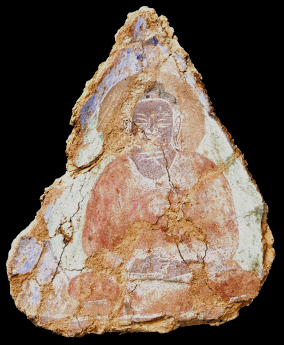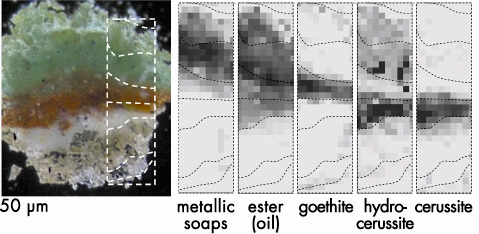Secrets of Bamiyan Buddhist murals (original) (raw)
Forceful blasts aimed at destroying the two Giant Buddha statues at the Bamiyan site and vandalism following these 2001 explosions damaged more than just the statues. They were also directly responsible for shattering important mural paintings that had once existed on the niches above the Buddhas as well as other valuable paintings inside the hundreds of caves (Figure 140).
 |
|---|
| Fig. 140: A painting fragment from the Foladi cave. This painting of a Buddha figure was identified as an oil painting (© NRICPT). |
The Bamiyan site is important both historically and artistically for its place along ancient cultural and material routes on the Silk Road linking the East and the West. It was included in the World Heritage List in Danger in 2003 and designated as a subject to be protected through international cooperation. This project has been funded by the UNESCO/Japanese Funds-in-Trust so that the conservation project ‘Safeguarding of the Bamiyan Site’ could be overseen by UNESCO. In order to perform satisfactory conservation intervention and provide a deepened knowledge of painting technologies stemming from Bamiyan along the vast Silk Road area, a wide range of scientific diagnosis has been used to reveal the manufacturing techniques and deterioration mechanisms of various mural paintings from over 50 caves dating back to a period between the 5th and 9th centuries AD. In particular, synchrotron-based analyses were performed at the ESRF with the aim of identifying the inorganic pigments and alteration products, and also the organic binders. Thus, a multi-modal analysis was carried out on both beamline ID18F (micro X-ray fluorescence, µXRF, and micro X-ray diffraction, µXRD) and beamline ID21 (micro Fourier Transform Infrared, µFTIR).
Elemental analyses were a first step to identifying the pigments and grounds. We found compounds containing metals such as lead, copper, calcium, mercury, iron and arsenic. These preliminary data were then refined thanks to micro X-ray diffraction. This technique is highly valuable for the precise identification of phases. It was particularly useful to distinguish pigments sharing common elemental composition. For example, various lead pigments were identified such as oxides, sulphates, carbonates, chlorides. It was also possible to distinguish various compositions of the same pigment, for example lead whites, containing differing proportions of lead carbonates (cerussite, PbCO3) and lead hydroxycarbonates (hydrocerussite, Pb3(CO3)2(OH)2). Such identification is very important because it can give indication of a possible choice of pigment quality and/or a specific use of these pigments by the painter. In parallel to these identifications, phases were mapped across transversal cross-sections to reveal their distribution. Indeed, these Buddhist paintings usually present a very complex stratigraphy with the superposition of often 5 or 6 layers (Figure 141). To look at this stratigraphy, µFTIR 2D-mappings were acquired. This permitted an identification of the organic binders as well as their localisation within the painting’s multi-layered structure.
 |
|---|
| Fig. 141: Micro-FTIR analysis of a pressed painting fragment from Foladi. Visible light picture (left). Some of the ingredients (organic binders and pigments) identified and mapped by µFTIR (right). |
Interestingly, the organic components also revealed complex compositions and distributions. A wide variety of organic materials were used, with an apparent intentional choice correlating to their role and their location (e.g. within sizing layers, paint layers, mordant, varnish and glaze). Oil was identified in many fragments, in addition to proteins, resins and polysaccharides. This discovery of mid-seventh century oil paintings is one of the oldest known to date.
Even more surprisingly, µFTIR enabled an identification of hydride materials, obtained by reaction of metallic (such as lead or copper) compounds with oil, leading to metallic carboxylates (soaps). The use of a similar formulation was already established in ancient cosmetics, but once again, their presence in such ancient paintings was a real discovery.
The chemical and structural study of a complex multi-layered system such as these paintings exemplifies the potential of a correlative analysis using micro- synchrotron-based techniques. The high spatial resolution associated with a high detection limit and short dwell time allows precise 2D chemical and/or structural mappings. On a more general level, this type of 2D information together with advanced data processing should lead to a better understanding of painting techniques, both of the material compositions and the manner in which the paint was applied. These results have given us a completely new view on painting history and will certainly encourage similar analyses of ancient paintings worldwide.
Principal publication and authors
M. Cotte (a,b), J. Susini (b), V. Armando Solé (b), Y. Taniguchi (c), J. Chillida (d), E. Checroun (e), P. Walter (a), J. Anal. At. Spectrom. 23, 820 (2008).
(a) Centre of Research and Restoration of the French Museums - UMR171 CNRS, Paris (France)
(b) ESRF
(c) Japan Center for International Cooperation in Conservation – National Research Institute for Cultural Properties, Tokyo (Japan)
(d) Painting restorer, Barcelona (Spain)
(e) Painting restorer, Paris (France)